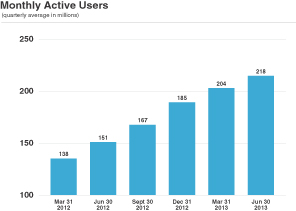Twitter IPO Filing Shows It Ain’t No Facebook
Talk of the power, future and technology of social networking always centers on two companies: Facebook and Twitter. Yet despite that equal billing, filings published today in advance of Twitter’s initial public offering show that the company is significantly smaller than its rival, and is likely to remain so.
Twitter is seeking to raise $1 billion in its forthcoming IPO, and reports that it has 215 million monthly active users. That’s not much advance on the “more than 200M” the company boasted of last December. When Facebook was eight years old, as Twitter is now, it had over 600 million active users; it now has 1.15 billion.
Worse, for Twitter, there are signs that it may not be able to grow the number of people who use its service by much more. The filings published today cheerfully point out that since there are 2.4 billion Internet users worldwide there is plenty of room to grow. But they also note that:
“We anticipate that our user growth rate will slow over time as the size of our user base increases.”
That’s a sensible and expected disclosure. But a look at this chart of Twitter’s active user count from today’s filings suggests that may have already started to happen.

Comparing the company’s growth over time with Facebook’s adds further evidence that Twitter is likely destined to remain a significantly smaller network – and company – than Facebook.

Twitter’s plans for finding more users hinge on making use of its impressive public profile thanks to the media and public figures from politics to Hollywood embracing the service. That’s something the company mentions throughout the document published today, saying it will use this strategy to boost growth outside the U.S.:
“We seek to foster a broad and engaged user community, and we encourage world leaders, government officials, celebrities, athletes, journalists, sports teams, media outlets and brands to use our products and services to express their views to broad audiences”
The filing doesn’t suggest why Twitter’s public profile hasn’t lured more people to regularly use the service. A report earlier this month claimed that Twitter’s leaders were fighting churn, where new users left after trying the site–perhaps because they found its culture and features too complicated to be worth learning.
That may be why Twitter has tweaked its service in recent months in ways that make it more like its outsize rival (see “Facebook and Twitter Are Converging”). However, Twitter’s S-1 suggests that may not be a good idea, making an obvious note in a section on “Risks Related to Our Business and Our Industry” that:
“Facebook operates a social networking site with significantly more users than Twitter and has been introducing features similar to those of Twitter.”
Whether Twitter can carve out a profitable niche as Facebook’s much, much smaller rival is unclear. The document published today show that Twitter brought in $317 million in revenue last year but posted a loss of $79 million. The company lost $69 million in just the first half of 2013. Its revenue has climbed over the past several years, but it still has a ways to go to become a profitable business–something Facebook achieved before its 2012 IPO.
Keep Reading
Most Popular
Large language models can do jaw-dropping things. But nobody knows exactly why.
And that's a problem. Figuring it out is one of the biggest scientific puzzles of our time and a crucial step towards controlling more powerful future models.
The problem with plug-in hybrids? Their drivers.
Plug-in hybrids are often sold as a transition to EVs, but new data from Europe shows we’re still underestimating the emissions they produce.
How scientists traced a mysterious covid case back to six toilets
When wastewater surveillance turns into a hunt for a single infected individual, the ethics get tricky.
Google DeepMind’s new generative model makes Super Mario–like games from scratch
Genie learns how to control games by watching hours and hours of video. It could help train next-gen robots too.
Stay connected
Get the latest updates from
MIT Technology Review
Discover special offers, top stories, upcoming events, and more.